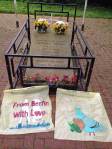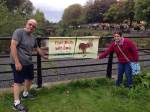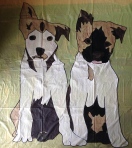Nantwich, UK on August 28, 2014 :
We love our animals. OK, maybe not mosquitos so much. But since they pollinate the cacao plant and therefor keep us supplied with chocolate, we have to accept them. Cats on the other hand run the internet. Often it seems like only the next picture or video of a cute baby animal can help humankind to hold on to the thin thread of sanity it still keeps in its hands. Animals are helpful and adorable. Animals impress us with their intelligence, their skills, determination and their loyalty. Animals are vulnerable and not afraid of it. We anthropomorphize them, and idealize them. They demand our love, admiration and protection. Though sometimes I think with some despair that it is easier to find people willing to support animals than some not remotely less worthy human causes.
Yet, when we find ourselves in times of war or conflict all cuteness is forgotten and we are happy to let animals die for our causes. Millions of animals were relied upon by all sides in the Great War. The story of World War I war horses has been brought to the stage and to the movies. Due to the advances in military technology the conditions on the front were often more dangerous for horses than for humans. Next to 10 million soldiers 8 million military horses died. And had it not been for the veterinarian corpses the number had been higher.
Thousands of other animals, which were used in transport, logistics, cavalry, communication, and as mascots, died as well. Everything from mules, camels and elephants to pigeons and dogs. Pigeon 785-15 lifted itself up to fame when it under fierce attack from poison gas and shells and as the last available hope delivered a vital message in June 1916 during the battle of Verdun. Even the common European glowworm was collected in jars and used in the trenches as a source of light to read by.
Animals at the home front suffered a fate not much better. They were killed in fear of an invasion or slowly starved to death as the supply with food was low and the humans went hungry already.
There is a discrepancy in our behavior and I don’t think it has change much. I don’t believe it is healthy for a society to anthropomorphize animals and use them as a substitute and sometimes main outlet of human affection. But in times of conflicts it seems like a button is switched and we lose something essential human what shows also in the way we look at animals. It might prevent us to see ourselves in others too.
[Disclaimer: I did not solely base the decision to bring this aspect of WWI up in the project on the possibility it offered to paint Tom Hiddleston on a bag – though it would be a perfect reason – but Heather, who I thank for bringing From Berlin With Love to her hometown together with her sister Emma and her Dad, loves to flood the internet with cats too – not that I mind – and the incongruity of human behavior towards animals between relatively peaceful times and war was striking.]
 |
 |
 |
 |
 |
 |
 |
 |
 |
 |
 |
 |
 |
 |
 |
 |
 |
 |
 |
||
 |
 |
 |
 |
 |
 |
